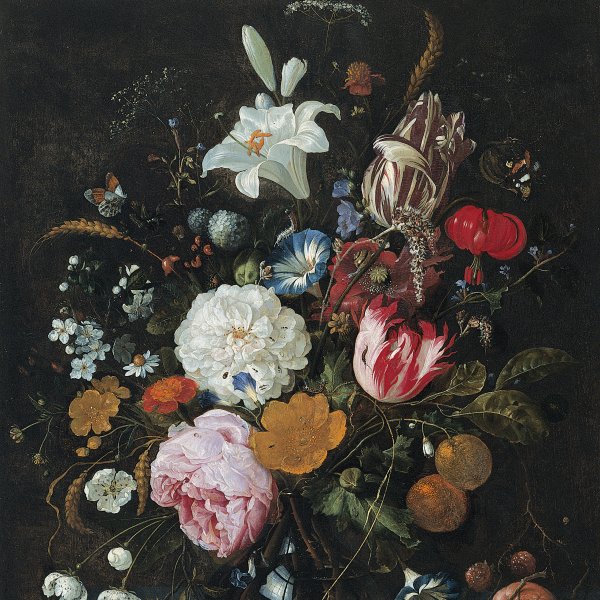Jan Davidsz. de Heem
Utrecht, 1606-Amberes, 1683/4
Johannes van Antwerpen, known as Jan Davidsz. de Heem, specialised in still lifes and floral paintings. He was born in Utrecht in 1606, the son of David de Antwerpen, a Catholic musician. In 1625 the artist moved with his family to Leiden, where he adopted the surname of “de Heem” and married his first wife Aletta van Weede, with whom he had three sons, one of them the painter Cornelis de Heem.
Nothing is known of De Heem’s training but his first works, painted in Leiden between 1625 and 1630, reveal the marked influence of Balthasar van der Ast’s floral still lifes as well as the monochromatic “breakfast pieces” of Heda and Pieter Claesz. De Heem’s most original works from his Leiden phase are his still lifes with books. In the early 1630s he moved to Antwerp where he lived and remained active over the following years although he also spent lengthy periods in Utrecht.
In 1635 De Heem is recorded in the painters’ guild of the city, and in 1637 he became a citizen. In Antwerp he made contact with the Flemish painter Daniel Seghers, with whom he collaborated on various works and from whom he borrowed the motif of garlands of flowers. De Heem was also familiar with the work of Frans Snyders.
During the 1640s the artist began to develop a new type of still life of a rich, highly decorative sort in which a wide variety objects, including fruit, flowers, precious vessels, glasses, silver and animals, are arranged on top of a table covered with a rug.
Following the death of his first wife, De Heem married again in 1644 to Anna Ruckers. In 1667 he returned to Utrecht and in 1669 is recorded in the painters’ guild in that city. He opened a studio in which his sons Cornelis and Jan Jansz. de Heem were trained, as well as notable painters such as Jacob Marrell and Abraham Mignon. Following the occupation of Utrecht by French troops under Louis XIV, he returned to Antwerp, were he remained until his death.
Nothing is known of De Heem’s training but his first works, painted in Leiden between 1625 and 1630, reveal the marked influence of Balthasar van der Ast’s floral still lifes as well as the monochromatic “breakfast pieces” of Heda and Pieter Claesz. De Heem’s most original works from his Leiden phase are his still lifes with books. In the early 1630s he moved to Antwerp where he lived and remained active over the following years although he also spent lengthy periods in Utrecht.
In 1635 De Heem is recorded in the painters’ guild of the city, and in 1637 he became a citizen. In Antwerp he made contact with the Flemish painter Daniel Seghers, with whom he collaborated on various works and from whom he borrowed the motif of garlands of flowers. De Heem was also familiar with the work of Frans Snyders.
During the 1640s the artist began to develop a new type of still life of a rich, highly decorative sort in which a wide variety objects, including fruit, flowers, precious vessels, glasses, silver and animals, are arranged on top of a table covered with a rug.
Following the death of his first wife, De Heem married again in 1644 to Anna Ruckers. In 1667 he returned to Utrecht and in 1669 is recorded in the painters’ guild in that city. He opened a studio in which his sons Cornelis and Jan Jansz. de Heem were trained, as well as notable painters such as Jacob Marrell and Abraham Mignon. Following the occupation of Utrecht by French troops under Louis XIV, he returned to Antwerp, were he remained until his death.





